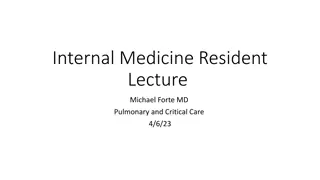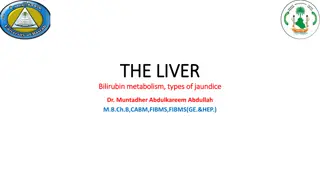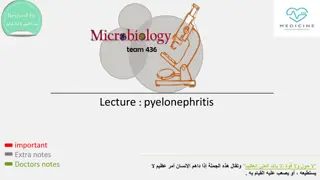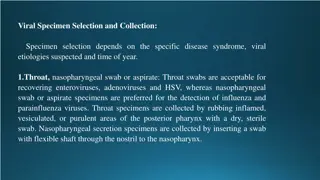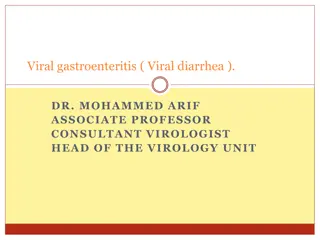FUO: Classic Presentations and Etiologies
Fever of Unknown Origin (FUO) presents a diagnostic challenge in clinical practice. This article delves into classic presentations such as Neutropenic FUO, Nosocomial FUO, and HIV-associated FUO. It also explores various causes including infections, neoplasms, and inflammatory diseases. The elderly population, multisystem diseases, and giant-cell arteritis as common etiologies are discussed. With increasing fever duration, infectious causes decrease, highlighting the need for comprehensive investigation. Different categories of causes and their prevalence in cases lasting over six months are detailed.
Download Presentation

Please find below an Image/Link to download the presentation.
The content on the website is provided AS IS for your information and personal use only. It may not be sold, licensed, or shared on other websites without obtaining consent from the author.If you encounter any issues during the download, it is possible that the publisher has removed the file from their server.
You are allowed to download the files provided on this website for personal or commercial use, subject to the condition that they are used lawfully. All files are the property of their respective owners.
The content on the website is provided AS IS for your information and personal use only. It may not be sold, licensed, or shared on other websites without obtaining consent from the author.
E N D
Presentation Transcript
FUO S.Abolghasemi,MD
Classic FUO: Temperatures of >38.3 C (>101 F) on several occasions, Duration of fever >3 weeks, Three outpatient visits or 3 days in the hospital without elucidation of a cause or 1 week of "intelligent and invasive" ambulatory investigation Nosocomial FUO: Temperature of 38.3 C ( 101 F) in whom infection was not manifest or incubating on admission. Three days of investigation, including at least 2 days incubation of cultures
Neutropenic FUO : temperature of 38.3 C ( 101 F) on several occasions in a patient whose neutrophil count is <500/ L or is expected to fall to that level in 1 2 days. specific cause is not identified after 3 days of investigation, including at least 2 days' incubation of cultures HIV-associated FUO : temperature of 38.3 C ( 101 F) on several occasions over a period of >4 weeks for outpatients or >3 days for hospitalized patients with HIV infection. Investigation over 3 days, including 2 days' incubation of cultures
Infections Neoplasms Noninfectious Inflammatory Diseases Miscellaneous Causes : Drug fever, pulmonary embolism, factitious fever, the hereditary periodic fever syndromes [familial Mediterranean fever, hyper-IgD syndrome, tumor necrosis factor (TNF) receptor associated periodic syndrome (also known as TRAPS or familial Hibernian fever), and congenital lysosomal storage diseases such as Gaucher's and Fabry's disease Undiagnosed Causes
In the elderly, multisystem disease is the most frequent cause of FUO, giant-cell arteritis being the leading etiologic entity in this category. In patients >50 years of age, this disease accounts for 15 20% of FUO cases. Tuberculosis is the most common infection causing FUO in the elderly, colon cancer is an important cause of FUO with malignancy in this age group
as the duration of fever increases, the likelihood of an infectious cause decreases,even for the more indolent infectious etiologies Causes of FUO Lasting >6 Months: None identified 19% Miscellaneous causes 13% Factitious causes 9% Granulomatous hepatitis 8% Neoplasm 7% Still's disease 6% Infection 6% Collagen vascular disease 4% Familial Mediterranean fever 3% No fever 27%
Patient's country of origin, recent and remote travel (including past service in foreign wars), unusual environmental exposures associated with travel or hobbies (e.g., caving, hunting, and safaris), and pets. Specialized Diagnostic Studies: Lab tests( CBC, B/C,PBS, serologies,LFT,TFT,ANA,PPD,ESR,CRD,VDRL,....) Imagings Scans Biopsies
NOSOCOMIAL FUO: The original surgical or procedural field More than 50% of patients with nosocomial FUO are infected Intravascular lines, septic phlebitis, and prostheses Occult infections Clostridium difficile colitis may be associated with fever and leukocytosis before the onset of diarrhea.
25% of patients with nosocomial FUO, the fever has a noninfectious cause. acalculous cholecystitis, deep-vein thrombophlebitis, and pulmonary embolism. Drug fever, transfusion reactions, alcohol/drug withdrawal, adrenal insufficiency, thyroiditis, pancreatitis, gout, and pseudogout IV lines must be changed (and cultured), drugs stopped for 72 hours, and empirical therapy started if bacteremia, fungemia, or persistently high virus loads are a threat.
NEUTROPENIC FUO: 50 60% of febrile neutropenic patients are infected, and 20% are bacteremic susceptible to focal bacterial and fungal infections,to bacteremic infections, to infections involving catheters and to perianal infections. In these patients, severe mucositis, quinolone prophylaxis, colonization with methicillin-resistant S. aureus, obvious catheter- related infection, or hypotension dictates the use of vancomycin plus ceftazidime, cefepime, or a carbapenem with or without an aminoglycoside to provide empirical coverage for bacterial sepsis.
HIV-ASSOCIATED FUO: The infectious etiology varies with the extent of immunosuppression and the geographic region Mycobacterium avium or M. intracellulare, tuberculosis, toxoplasmosis, CMV infection, Pneumocystis infection, salmonellosis, cryptococcosis, histoplasmosis, non-Hodgkin's lymphoma, and (of particular importance) drug fever are all possible causes of FUO FUO has an infectious etiology in >80% of HIV-infected patients, but drug fever and lymphoma remain important considerations
vital-sign instability or neutropenia is an indication for empirical therapy Cirrhosis, asplenia, disease-modifying biologic therapy, intercurrent immunosuppressive drug use, may all tip the balance toward earlier empirical anti-infective therapy. If the TST is positive or if granulomatous hepatitis or other granulomatous disease is present with anergy (and sarcoid seems unlikely), then a therapeutic trial for tuberculosis should be undertaken, with treatment usually continued for up to 6 weeks. A failure of the fever to respond over this period suggests an alternative diagnosis.
The response of rheumatic fever and Still's disease to aspirin and nonsteroidal anti-inflammatory drugs (NSAIDs) may be dramatic. The effects of glucocorticoids on temporal arteritis, polymyalgia rheumatica, and granulomatous hepatitis are equally dramatic their use be avoided unless infection has been largely ruled out and unless inflammatory disease is both probable and debilitating or threatening The initiation of empirical therapy does not mark the end of the diagnostic workup



